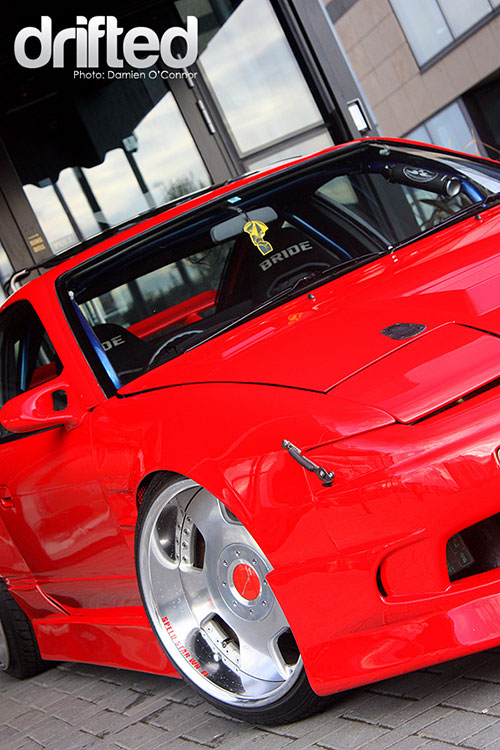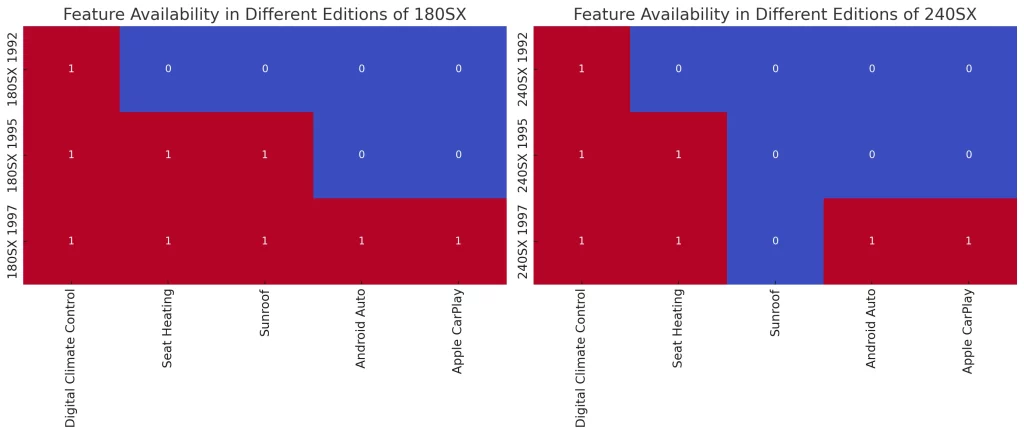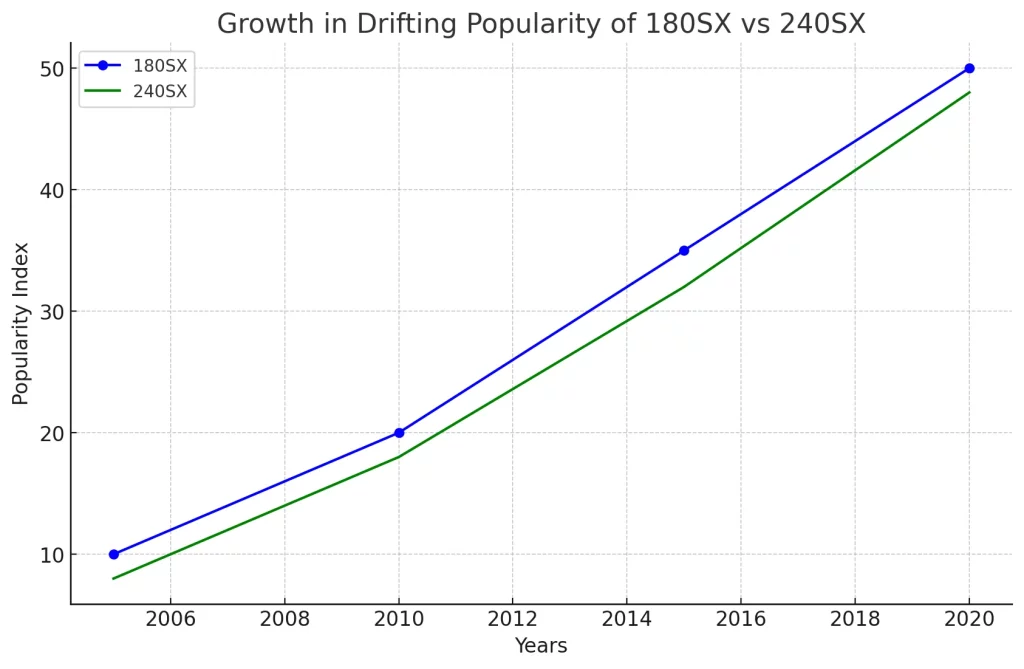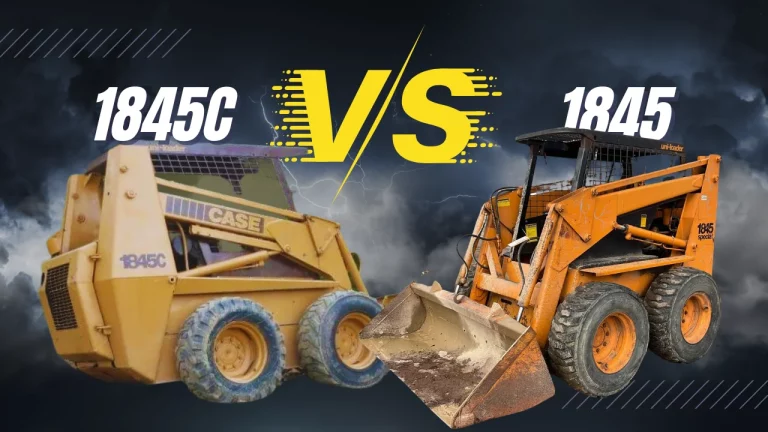Difference between 180sx and 240sx Nissan: Unraveling Key Distinctions

The Ultimate Showdown: Difference Between 180SX and 240SX 🏎️
When it comes to Japanese sports cars that have left an indelible mark on the automotive world, few models spark as much debate and enthusiasm as the Nissan 180SX and 240SX. These two hatchback vehicles, the Nissan 240SX and Nissan 180SX, look almost like twins but they’re not! Trust us, the differences are more than just a number. But what exactly sets them apart?
📌 Why This Matters: Understanding the difference between 180SX and 240SX isn’t just for car nerds; it’s crucial for anyone thinking about buying one of these classic sports cars, or even for those who just want to win a debate on which is the better model!
🔍 What You’ll Learn:
- Why these two cars are so special.
- How their engines are like apples and oranges.
- Why some people prefer one over the other.
👉 Let’s Get Rolling: This article is your ultimate guide to all the nooks and crannies that separate these two automotive legends. We’ll dive into their history, engines, design, and much more. So, buckle up, because this is going to be a turbo-charged ride through the world of Nissan’s most debated sports cars!
| Feature | 180SX | 240SX |
|---|---|---|
| Years produced | 1988-1998 | 1989-1998 |
| Body style | 2-door coupe | 2-door coupe |
| Layout | Front-engine, rear-wheel drive | Front-engine, rear-wheel drive |
| Engine | 1.8L DOHC I4 (CA18DET) | 2.4L DOHC I4 (KA24DE/KA24E) |
| Power | 155 hp (CA18DET) | 140-155 hp (KA24E/KA24DE) |
| Torque | 137 lb-ft (CA18DET) | 150-160 lb-ft (KA24E/KA24DE) |
| Transmission | 5-speed manual | 5-speed manual |
| Suspension | MacPherson strut (front), multi-link (rear) | MacPherson strut (front), multi-link (rear) |
| Brakes | Ventilated disc (front), solid disc (rear) | Ventilated disc (front), solid disc (rear) |
| Curb weight | 2,600-2,800 lbs | 2,800-3,000 lbs |
History and Background 📚

The Birth of Two Legends: 180SX & 240SX 🎉
It’s the late ’80s, and Nissan wants to make a splash in the sports car market. Enter the 180SX and 240SX—two cars born around the same time, 1989 to be exact, but destined for different paths. The main differences between these two models lie in their engines.
🌍 Geography Matters: The 180SX was the darling of the Japanese Market (JDM), whereas the 240SX set its wheels on North American soil. The Nissan 240SX S13 is known as the S13 Silvia or 180SX in Japan and the 200SX RS13U in Europe. This popular car model features a powerful engine.
🤝 Family Ties with Nissan Silvia: These two aren’t just standalone models; they’re more like cousins to the Nissan Silvia. All of them share the same Nissan “S” chassis and engine, making them, in essence, automotive siblings of the same model. The 180sx is a variant of the Nissan S14 and S13 chassis model.
📈 The Popularity Contest: Both cars quickly gained a cult following. But their fan bases were somewhat separated by oceans, with the 180SX being a hit in Japan and the 240SX gaining traction in the U.S.
What Makes Nissan 180SX and 240SX Special? 🌟
🔥 Not Just Another Sports Car: Look, lots of cars are fast. Some even look cool. But the 180SX and 240SX? They’re in a league of their own.

🔧 Under the Hood: The 180SX came with a 1.8-liter turbo engine hovering around the 170-205 horsepower range depending on the version and modifications. The 240SX had a 2.4-liter naturally aspirated engine ranging from 140-155 horsepower depending on the specific variant and modifications.. In simple terms, the 180SX was like a caffeinated squirrel—fast and furious. The 240SX, on the other hand, was more like a steady stallion—strong and reliable.
💨 Turbo Talk: The 180SX, with its turbo features, attracted speed enthusiasts, while the 240SX appealed to those who favored stability, thanks to its independent rear suspension.
👀 Why So Popular?:
- 180SX: The turbocharger, aggressive design, and JDM exclusivity make it a hot item for car enthusiasts.
- 240SX: The balanced performance, availability in multiple body types, and adaptability to modifications earn it solid street cred.
🛠 Community Love: One thing that stands out for both models is the community of enthusiasts who love tinkering with these cars. From engine swaps to body mods, these cars are like a canvas for automotive creativity.
Engine Specifications: 180sx vs 240sx 🛠️
| Features | Nissan 180SX | Nissan 240SX |
|---|---|---|
| Engine Size | 1.8L Turbocharged | 2.4L Naturally Aspirated |
| Drivetrain | Rear-Wheel Drive | Rear-Wheel Drive & All-Wheel Drive |
| Market | Japan | North America |
| Price Range | $15,000 – $25,000 | $10,000 – $20,000 |
The Heart of the Beast: CA18DET vs KA24E 🏎️
When it comes to engines, the 180SX and 240SX are like siblings who chose different career paths. One went into sprinting, and the other opted for long-distance running.
🔥 180SX: With its 1.8-liter turbocharged engine, the 180SX is the sprinter of the family. It’s all about high energy and quick acceleration, boasting a higher power output due to the turbocharger.
🐎 240SX: This one’s your long-distance runner with its 2.4l naturally aspirated engine. It doesn’t have the turbo boost, but it offers a consistent, dependable performance.
📊 Evolution Over Time: Both cars saw engine updates in later models, but the 180SX generally stayed ahead in the power game, thanks to its turbo features.
Supply Chain and Market Availability 🌏
Where Can You Get One? 🛒
Both models have been out of production for years, but their legacy lives on in the second-hand and restoration markets.

🇯🇵 180SX: Primarily sold in Japan, this model is a bit of a rare find elsewhere. But thanks to its enduring popularity, it’s still available through specialized dealers.

🇺🇸 240SX: Initially aimed at the North American market, this model is easier to find in the U.S., both in terms of the car itself and parts for modifications.
🔧 Aftermarket Support: One of the reasons these cars continue to be popular is the strong aftermarket community. From performance upgrades to aesthetic tweaks, the options are nearly endless.
Design and Aesthetics 🎨
More Than Just Good Looks 😎
At first glance, you might think these cars are quite similar. But look closer, and you’ll see the differences in their design philosophies.
🌪️ 180SX: With its aggressive and aerodynamic design, the 180SX looks like it’s going fast even when it’s parked. It’s the kind of car that says, “Hold on tight!”
🍃 240SX: This model took a softer approach with a rounded design. It’s stylish but less “in your face” about it, making it a bit more versatile for everyday use.
🚗 Special Editions: Both models saw various special editions and variations, each with unique design elements. Whether it’s a rear spoiler, alloy wheels, or new bumper designs, each iteration added something new to the mix.
Turbo and Other Performance Features 🚀
Turbo or Not To Turbo, That’s the Question 🤔
When it comes to turbo features, the 180SX and 240SX diverge like night and day.
🌟 180SX: Straight out of the factory, this car comes with a turbocharged SR20DET. It’s built for speed and performance, making it a hit among those who crave that extra ‘oomph.’
🌙 240SX: While it doesn’t come with a factory turbo option, the 240SX offers a stable and consistent performance. But for those who want more, the aftermarket community has got you covered with various turbo kits.
🛠️ Performance Tuning: Both cars are tuner-friendly. Whether it’s engine swaps or installing a turbocharger on a 240SX, the possibilities are exciting and almost endless.
Interior Features and Technology 🎛️

In the heatmap:
A “1” indicates that the feature is available in that particular edition.
A “0” indicates that the feature is not available.
Comfort Meets Tech 🎮
Interior of the 180SX
The 180SX offers a straightforward yet sporty coupes interior, often featuring fabric sport seats and essential amenities.
Interior of the 240SX
The 240SX, especially in later models, tends to offer a bit more in terms of interior comfort, including more advanced audio systems and sometimes even leather upholstery.
Tech and Amenities 📱
While neither car is a tech marvel by today’s standards, the 180SX often came with digital climate control, which was quite advanced for its time.
Drivetrain and Transmission 🛠️
What’s Under the Hood? 🏎️💨
Drivetrain Options for the 180SX
The 180SX is primarily rear-wheel drive (RWD), giving it that sporty, agile handling loved by enthusiasts, especially those into drifting.
Drivetrain Options for the 240SX
The 240SX offers both rear-wheel drive and an all-wheel-drive option. The versatility makes it a favorite for those who want more control in different driving conditions.
Transmission Choices 🕹️
Both models come with manual transmission options, but what really sets them apart is how those transmissions translate into performance. The turbocharged engine in the 180SX paired with its transmission choices often leads to a more exhilarating driving experience.
In Japan, the 180SX is available in two trim levels: “Type I” (Standard) and “Type II” (Advanced). Both come with either a 5-speed manual or a 4-speed automatic transmission. What’s even more exciting is that the Type II version offers the HICAS four-wheel steering system, adding another layer of control and excitement to your drive.
Drifting: The Sport that Loves Them 🏁

Sideways is a Way of Life 🔄
If cars could dream, the 180SX and 240SX would dream of drifting.
🎯 Why They’re Popular in Drifting: With their rear-wheel drive and easily modifiable engines, these cars are a drifter’s paradise. They’re so good that champions like Masato Kawabata have used them in competitions.
🏆 Famous Drifters: These models aren’t just popular; they’re stars in the drifting scene. Whether it’s in D1 Grand Prix or local drift events, you’ll often see these cars stealing the show.
Safety Features and Regulations 🛑
Safety First, Always 🚨
While the primary focus of these cars might be performance and design, safety isn’t compromised.
🇺🇸 240SX: Comes with automatic restraint seatbelts and was designed to meet the stringent safety regulations of the North American market.
🇯🇵 180SX: Though it lacks the advanced seatbelt features of the 240SX, it does come with other safety features like digital climate control.
🚧 Regulatory Impact: Different markets have different rules. For example, the absence of a factory turbo option in the 240SX was partially due to emission regulations in the U.S.
Real-world Experiences 🌍
Real People, Real Stories 🚗💨
When it comes to the Nissan 180SX and 240SX, the automotive community has a treasure trove of stories to share.
🛣️ Testimonials from Owners: While enthusiasts love the turbocharged power of the 180SX, many in the U.S. appreciate the 240SX for its reliability and aftermarket potential.
🛠️ Common Modifications: Whether it’s a turbo kit on a 240SX or an engine swap in an 180SX, both models are like a playground for car modders.
Conclusion 🎯
The Showdown: 180SX vs 240SX 🥊
After diving deep into both models, here’s the ultimate comparison.
📊 Key Similarities:
- Both are from Nissan.
- Both are rear-wheel-drive sports cars.
- Both have a strong following among car enthusiasts.
📈 Key Differences:
- Market: 180SX is JDM, and 240SX is American.
- Engine: 180SX is turbocharged; 240SX is not.
- Design: 180SX is more aggressive; 240SX is subtle.
🤔 Which One is For You?: If you’re looking for raw power and JDM exclusivity, go for the 180SX. If you’re in the U.S. and want a reliable sports car with endless modification possibilities, the 240SX is your bet.
FAQs ❓
You’ve Got Questions, We’ve Got Answers 🙋♀️🙋♂️
Here we’ll tackle some questions that pop up often when discussing these two iconic cars.
- Is the 180SX better than the 240SX?
- It depends on what you’re looking for. The 180SX has a more powerful engine, but the 240SX is more versatile in terms of modifications.
- Can you turbocharge a 240SX?
- Yes, many owners choose to install aftermarket turbo kits to boost its performance.
- Why is the 180SX more expensive?
- The JDM exclusivity and higher power output often make the 180SX more expensive in the enthusiast car market.
- Are these cars good for beginners?
- Both cars are beginner-friendly, especially if you’re interested in learning about car modifications.





